|
Some notes on the Star class
by Russ Elliott
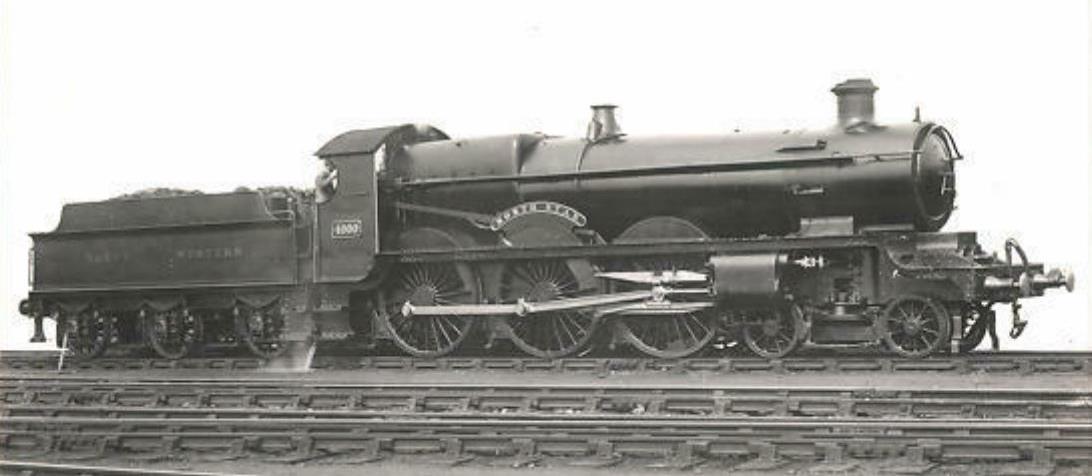
The pioneering North Star (number 40) was rebuilt as a 4-6-0 in November 1909, and received a new curved front-end footplate and a scalloped cover over the inside cylinders at the same time. It was renumbered 4000 in December 1912. It is pictured here in unlined austerity livery immediately prior to 1919, when it received a cast-iron chimney. The brass beading has been stripped from the splashers, but the smokebox damper and bogie brakes are still in place. The footplate is 2½" higher than the rest of the class, and would remain so even when converted later into a Castle in November 1929.
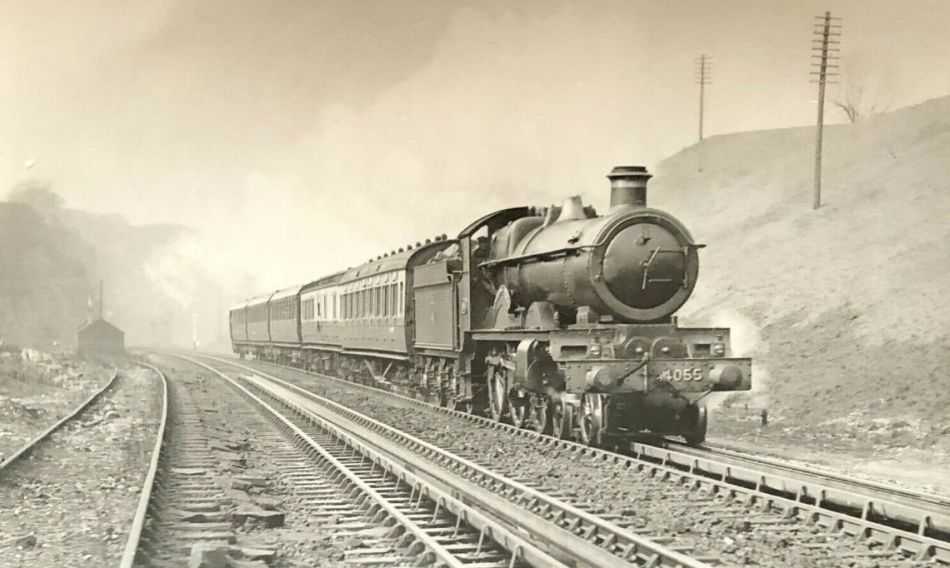
4055, running with an intermediate tender, enters Keynham troughs with a Cardiff to Brighton express. The last three coaches are a southern set.
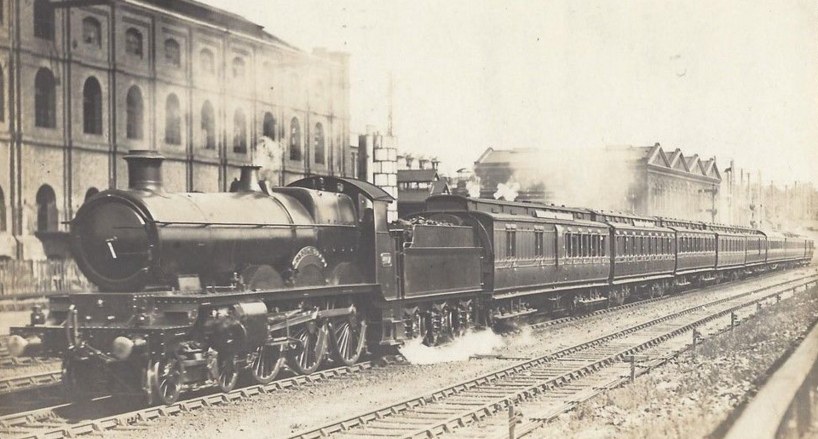
Star on a down train to Ilfracombe, passing Kensal Green, c 1923
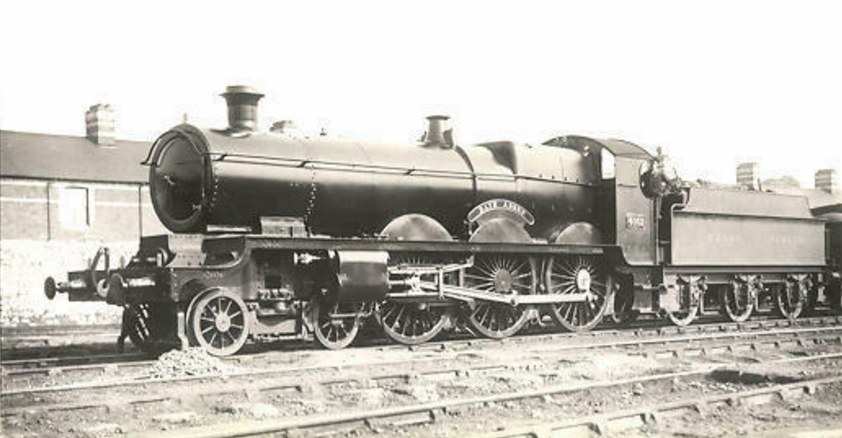
4063 'Bath Abbey' at Newton Abbot, in early 1920s condition, with bogie brakes and a cast-iron tapered chimney. It was rebuilt as a Castle (5083) in 1937.

4039 'Queen Matilda' in early 1920s condition
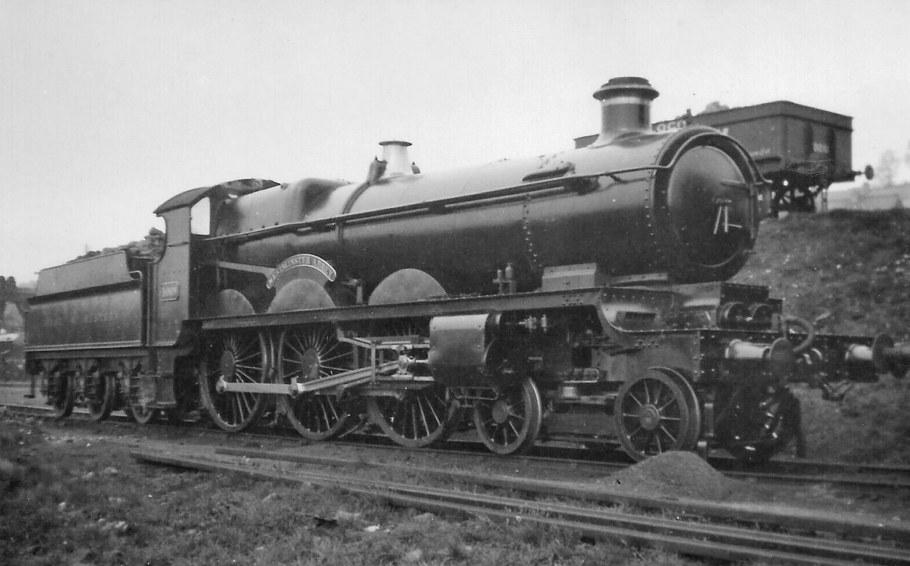
4069, newly renamed 'Westminster Abbey', at Laira in 1926

4045 'Prince John' at Exeter, mid-1920s
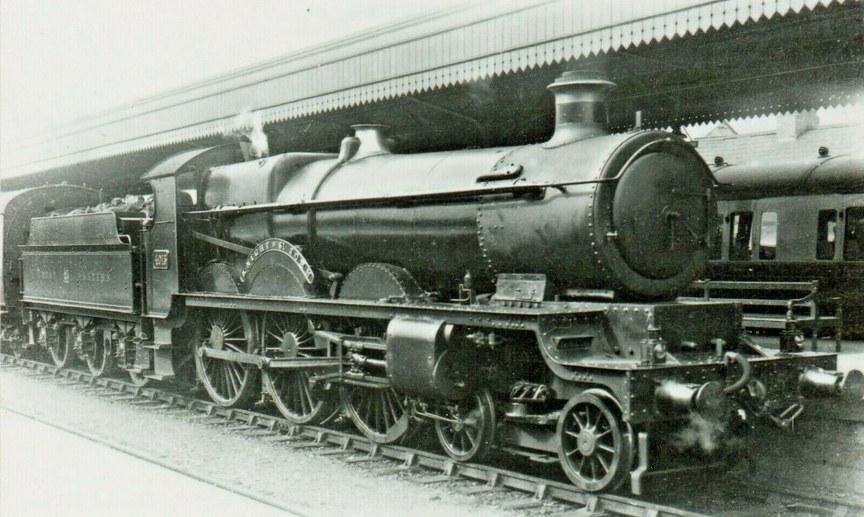
4015 'Knight of St John' at Taunton, late 1920s to early 1930s
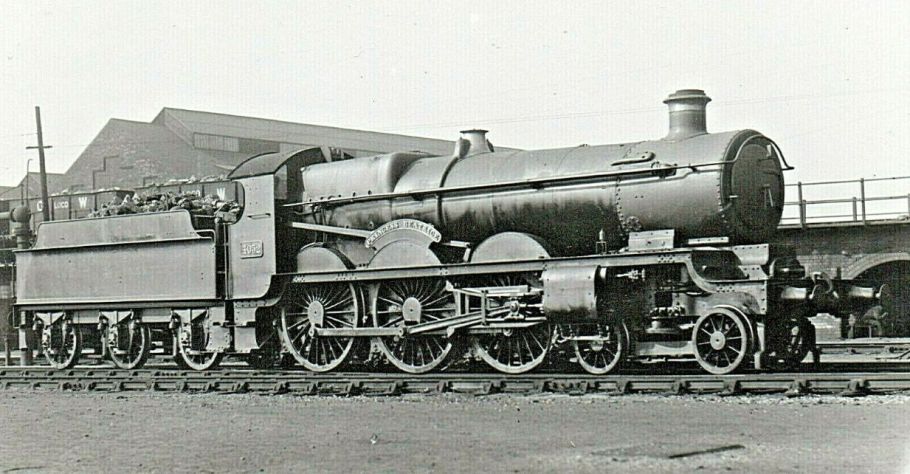
4052 'Princess Beatrice' at Old Oak Common in 1933. The loco's smokebox wrapper has a patch, indicating its boiler has been previously carried by an outside-steampiped loco, likewise with 4020 pictured below.
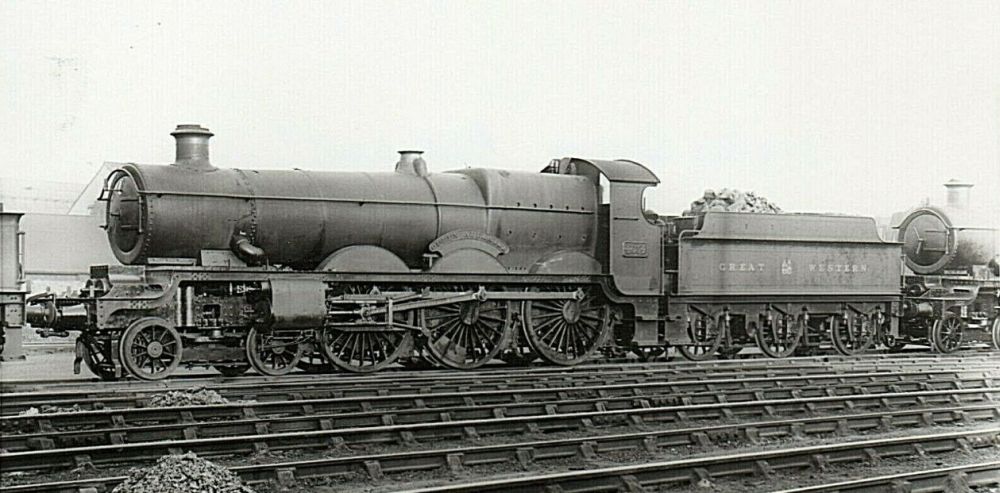
4034 'Queen Adelaide ' at Swindon on 18 April 1934. It had received elbow pipes two years previously.
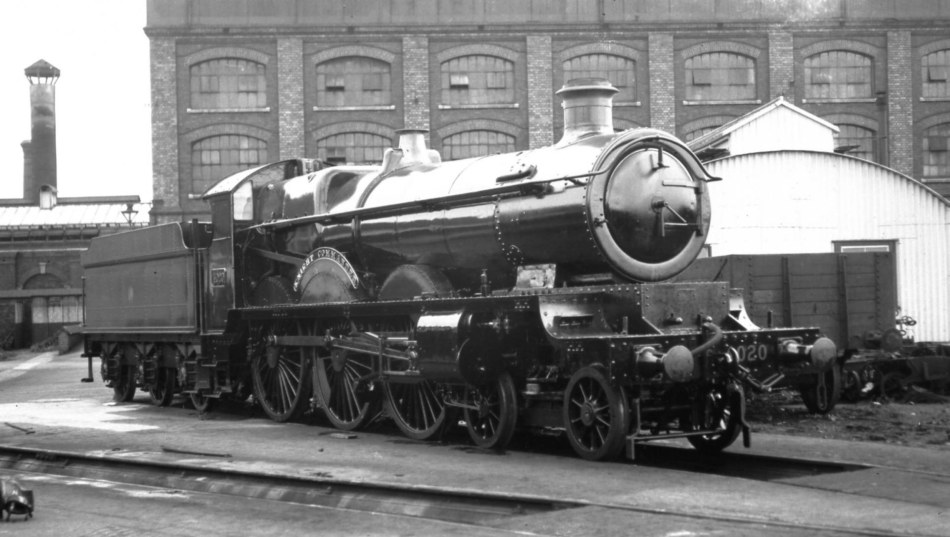
4020 'Knight Commander', the last of the 'Knight' series, at Swindon in the mid- to late-1930s, with a Collett 3500g tender.
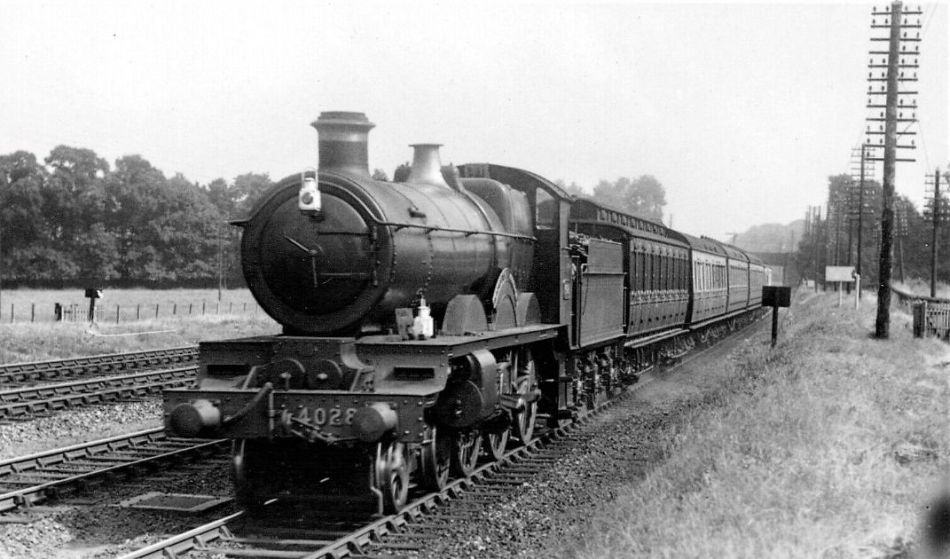
4028 'Romanian Monarch' heads a short down local passenger, probably late 1930s, with the leading clerestory looking like it's in all-over brown livery. The location is Lower Basildon, just beyond the western end of Goring troughs. The loco would lose its name in November 1940.
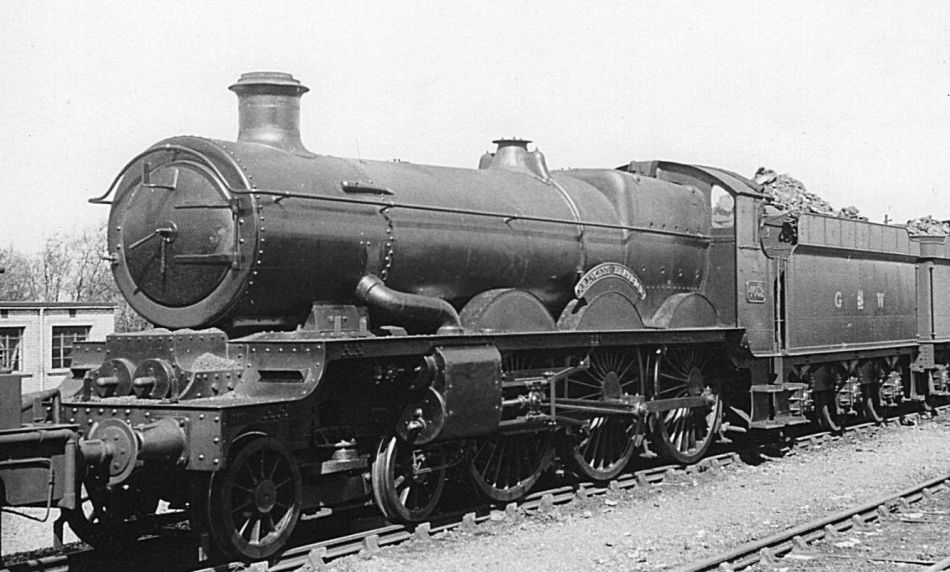
4052 'Princess Beatrice' received Castle-type outside steam pipes in 1939, and is seen here in post-WWII days in unlined green.
| 4012's cab, in early condition, with a wooden roof |
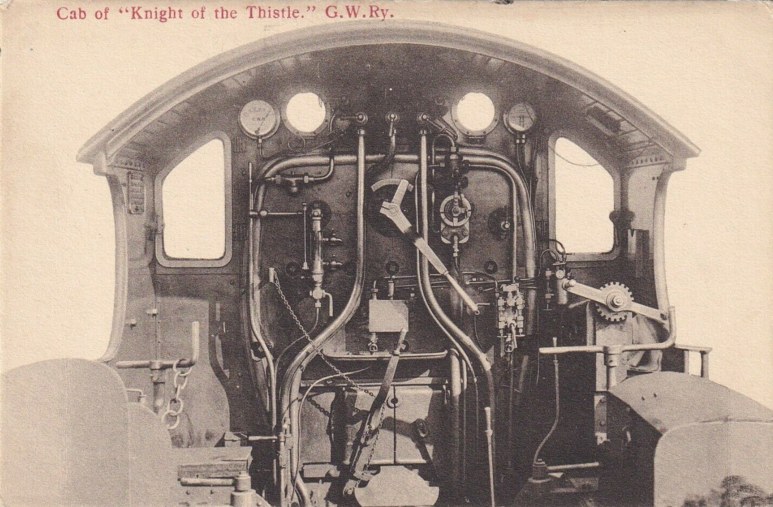 |
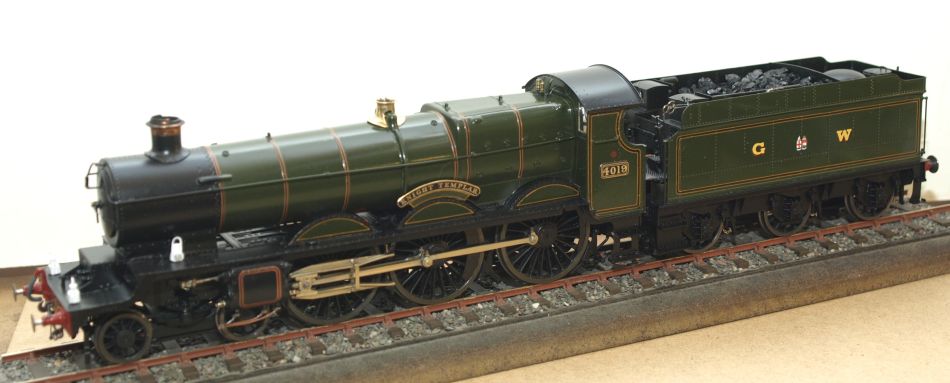
Ted Kanas' 7mm 4019 'Knight Templar' with a Collett 4000g tender – more views can be found here.
The following notes give details of the variations in the class.
| General |
Build dates, names, and withdrawal dates, together with the fifteeen locos rebuilt as Castles (4000/9/16/32/37 in 1925–26 and 4063–72 in 1937–39), can be found here. |
| Footplate framing |
4000 was built with 'square drop' framing at the front, 4001 onward had the curved style. (4000 would subsequently receive the curved style.) |
| Front cover for inside cylinders |
'Square box' on 4001–20, the remainder 'scalloped'.
The prototype 'North Star' loco, renumbered from 40 to 4000 in 1912, had a footplate 2½" higher than the rest of the class, and remained so even when rebuilt as a Castle. |
| Boiler types |
Boiler type was No 1. Initial locos fitted with superheater no 1, but superheater type no 3 soon became the standard for the class, with older locos being updated by May 1913.
(The above is a considerable simplification, the very early boilers having non-superheat. Also, the process of replacing early 'half-cone' boilers with the later standard 'full-cone' version was probably not completed until c 1921.) |
| Cylinders |
Initial locos had 14¼" diameter cylinders, but from 4041 onward (in 1913) this was increased to 15" diameter, which resulted in an increased tractive effort. The larger diameter cylinder size was applied to earlier locos as they passed through the works. |
| Boiler feed |
Initial locos had backhead-fed boilers, very soon replaced by topfeeds, which first made their appearance from 4041 onward in 1913. |
| Ejectors |
Fitted with 4-cone ejectors from 1914 (4046) onward, with earlier engines being similarly re-fitted thereafter. All had been so fitted by 1919. |
| Lubricator pipe cover style |
The right-hand side was initially of early pattern. The later pattern was fitted probably from 4061 onward, with earlier locos being updated on works visits.
On the left-hand side, most locos did not have a lubricator pipe cover, but a few locos did. The presence of a lubricator cover on the left-hand side probably indicates the later fitting of a 'five-sight' feed lubricator rather than a 'three-sight' as would originally have been fitted. |
| Coupling rods |
The Princesses were initially fitted with fluted rods of special steel but later fitted with standard fishbelly. 4061/2/7–72 had I-section coupling rods. |
| Slidebars |
4001 and 4002 were initially fitted with non-standard I-section slidebars without the vertical strap, but these had reverted to standard T-section with vertical straps by 1909. |
| Speedometers |
Began to be fitted to the right-hand side rear driver from c 1937. |
| Buffers |
Initially fitted with Churchward standard taper. Collett tapered type started to appear in the 1930s, and Collett parallel types were seen in BR days. |
| Safety valve |
Tall safety valve casings were fitted initially, but most of the class migrated to the low type, introduced in 1927, in later years. Dated prototype pictures should be consulted. |
| Chimneys |
The first batch of ten locos initially appeared with a 1'6⅞" body diameter chimney, but all later batches (from 4011 onward) were fitted with a chimney of 1'8⅞" body diameter and 1'11¾" high, which became the standard for the class. Following the 'austerity' period of WWI, many * locos were fitted with a tapered cast-iron chimney from 1919–24. From 1939, a few locos received the Grange type of shorter 1'9" chimney. (These quoted heights do not include the 1¾" capuchon.) None received the fatter 1'10" diameter Castle type, short or tall (except of course those rebuilt as Castles).
* 4000/1/8/10/13/17/18/21/22/24/28/35/38/44/47/51/54/55/57/60/61–72 |
| Front footsteps |
4002/8/9 were fitted with front steps, but these were a hinderance to accessing the inside motion, and were removed later. |
| Bogie |
The first batch of ten locos was fitted with swing-link bogies, but all later batches were fitted with the Swindon version of the de Glehn bogie, and these were retrofitted to the first batch. |
| Cab footsteps |
4001–20 have apertures in the bottom section, 4021 onward are solid. |
| Tenders |
The first members of the class were coupled with early short-fender Churchward 3500g units, very soon thereafter (probably starting with 4031 in 1910) 3500g flush-riveted (normally) or (later) snaphead riveted long-fender units became the norm.
A few engines ran with 3500g Collett tenders during the early to mid-1930s. 4045 and 4022 ran with Great Bear's 8-wheel tender for a while in 1936. 4026, 4044 and 4055 ran with an 'intermediate' tender for a while.
With the exception of 4063, which received a 4000g tender c 1930, the class starting receiving standard 4000g Collett units from 1937.
Later, four members of the class ran with the Hawksworth flat-sided 4000g:
- 4036 ran with tender 4013 in 1948 and tender 4016 in 1950;
- 4053 ran with tender 4015 in 1950;
- 4058 ran with tender 4049 in June 1949 until withdrawal in April 1951;
- 4062 ran with tender 4056 in April to May 1950, tender 4014 in April 1952 until January 1953 and tender 4046 in July 1955 until withdrawal.
Some locos ran with the rare Dean 4000g tenders. 4043 ran with the unique Collett 8-wheeled tender 2586 between 6 February 1950 and 22 June 1950.
(For details of tender types allocated to the Stars rebuilt as Castles, see BRDatabase.) |
| Brass beading on splashers |
Removed during WWI and never replaced. |
| Bogie brakes |
Fitted from new, removal started November 1923 (and quickly completed, probably by 1925). |
| Cab front portholes |
Plating over started c 1924. |
| Reversing lever cover housing |
A few late surviving locos had a cover housing in front of the cab on the right-hand side. These seem to have appeared sometime during WWII. |
| Smokebox rivets |
Initially flush riveted, smokebox snaphead riveting started in 1922 with the appearance of 4061–72, and older locos started to show snapheads from c 1924. A Queen in 1932 has rivets on the back ring but the front ring still flush-riveted, and a rarer form is the converse. The late-surviving Stars ended up with rivets on both front and back smokebox rings. The early external smokebox damper mechanism was removed between 1917 and 1924 and plated over. |
| Whistle shields |
Fitted from 1927. |
| Steam pipes |
Originally all inside-piped, outside pipes started to be fitted from 1929, either elbow type or 'Castle' type. Some were never fitted with outside pipes.
Dates of outside steam pipe fitting: 4000–4029 and 4030–4072. These dates are tabulated below.
The difference between types of outside cylinder can be seen well here, which shows the top of the cylinder casing of the traditional Star being at the bottom of the footplate valance, whereas the top of 'Castle' type cylinder casings were at the middle of the footplate valance. |
| Front lamp iron |
From 1932, the upper lamp iron was transferred from the front of the chimney to the smokebox door. |
| Appearance dates of outside steam pipes |
| Loco | Elbow | 'Castle' type |
| 4001 | | 10/30 |
| 4002 | 12/29 | |
| 4003 | 3/49 | |
| 4004 | 3/46 | |
| 4007 | 5/47 | |
| 4008 | 7/33 | |
| 4014 | 7/35 | |
| 4015 | 12/48 | |
| 4018 | 5/31 | |
| 4019 | 5/48 | |
| 4020 | 3/49 | |
| 4021 | 7/48 | |
| 4022 | 6/48 | |
| 4024 | | 2/29 |
| 4026 | 10/32 | |
| 4031 | 8/48 | |
| 4033 | 4/40 | |
| 4034 | 6/32 | |
| 4035 | | 1/31 |
| 4036 | 7/43 | |
| 4038 | 8/32 | |
| 4039 | 12/48 | |
| 4040 | | 2/30 |
| 4041 | 10/47 | |
| 4042 | 5/48 | |
| 4043 | | 10/31 |
| 4044 | 10/46 | |
| 4045 | 1/46 | |
| 4046 | 1/49 | |
| 4047 | | 10/38 |
| 4048 | 8/32 | |
| 4049 | | 2/35 |
| 4050 | 6/46 | |
| 4051 | | 12/44 |
| 4052 | | 4/39 |
| 4053 | | 10/43 |
| 4054 | 10/45 | |
| 4055 | | 5/45 |
| 4056 | 8/49 | |
| 4057 | | 4/30 |
| 4058 | 10/44 | |
| 4059 | | 8/44 |
| 4060 | 12/30 | |
| 4061 | 7/49 | |
| 4062 | 3/50 | |
References
4000 'Star' class introduction, by John Daniel
'Star' class details, 4000 – 4029, by John Daniel
'Star' class details, 4030 – 4072, by John Daniel
BRDatabase (useful info on build, withdrawal and superheating dates, some shed allocations and tender types used)
GWR 4-6-0 Express Passenger Locomotives
The GWR Stars, Castles & Kings, O S Nock, David & Charles
Star Class Locomotives, Laurence Waters, Pen and Sword, ISBN 1473871026
Further pictures of Stars can be found in the 17 June 2022 issue of Going Loco
|